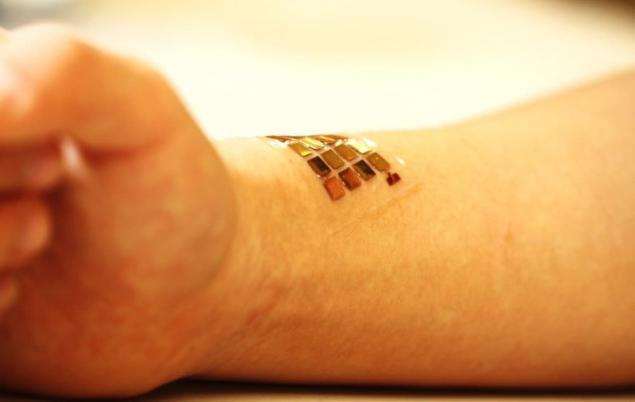672
Self-charging battery on the skin is stretched to charge portable devices
A team of researchers has developed a new way to power wearable electronics, using a soft battery, the thickness of only one millimeter, which can be extended on the skin as a patch.

Handheld and flexible sensors promise a wide range of applications, including such things as health monitoring, sale of tickets for sports events and robots with tactile sensations. Some of them must be connected to an external power source, while others have shown the ability to collect the mechanical energy of motion to be charged independently.
In search of interesting solutions of energy supply, which is lightweight and suitable for applications such mechanics, an international team of researchers led by materials scientists scientist John Rogers (John Rogers) from the University of Illinois, offers a completely new kind of battery.
To solve some of the problems in the creation of flexible power sources, the researchers cut a conventional lithium-ion battery with a tiny ultra-thin tiles. These tiles were then connected to wires and the array was integrated into soft, elastic material, and then covered with a final layer of hard rubber. The upper part of the battery cells, along with biosensors and chips, covered with layers of tiny solar cells.
The result is a waterproof device superthin and because the wires that connect the tiles, actually longer than the space between them, the battery is able to stretch. Testing has also shown that it can be stretched up to 30 percent while maintaining its functionality.
Command tells that the device, which shows the concept of the work can be attached to a person's skin as a patch to ensure working biosensor. It can also potentially be incorporated into smart clothes to provide new methods of energy storage.

Handheld and flexible sensors promise a wide range of applications, including such things as health monitoring, sale of tickets for sports events and robots with tactile sensations. Some of them must be connected to an external power source, while others have shown the ability to collect the mechanical energy of motion to be charged independently.
In search of interesting solutions of energy supply, which is lightweight and suitable for applications such mechanics, an international team of researchers led by materials scientists scientist John Rogers (John Rogers) from the University of Illinois, offers a completely new kind of battery.
To solve some of the problems in the creation of flexible power sources, the researchers cut a conventional lithium-ion battery with a tiny ultra-thin tiles. These tiles were then connected to wires and the array was integrated into soft, elastic material, and then covered with a final layer of hard rubber. The upper part of the battery cells, along with biosensors and chips, covered with layers of tiny solar cells.
The result is a waterproof device superthin and because the wires that connect the tiles, actually longer than the space between them, the battery is able to stretch. Testing has also shown that it can be stretched up to 30 percent while maintaining its functionality.
Command tells that the device, which shows the concept of the work can be attached to a person's skin as a patch to ensure working biosensor. It can also potentially be incorporated into smart clothes to provide new methods of energy storage.
reputation management, promotion in social networks and your crowd marketing of "SMPR" company
Do not put man at the center of his universe























